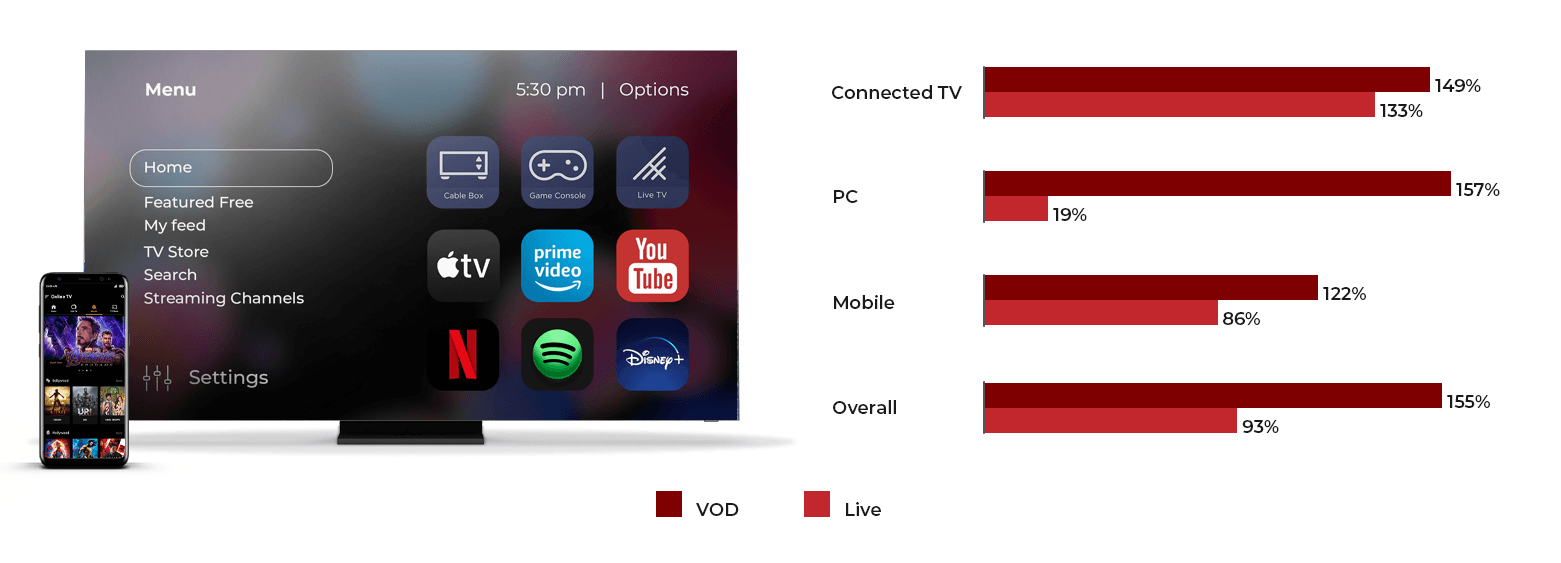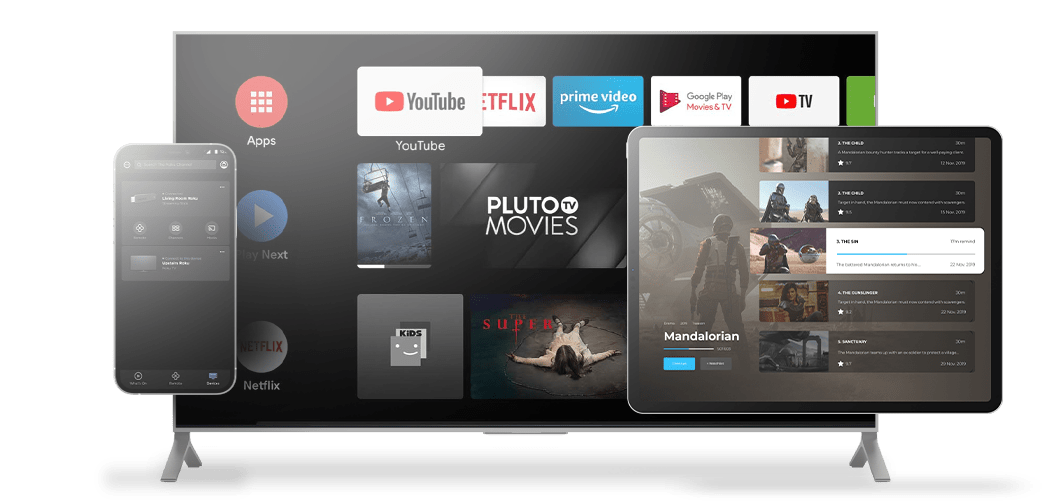According to statistics, we no longer watch TV in the same amount as a few years ago: people prefer to choose the right video on the Internet, and a new format of video watching, VoD (“video on demand”), is gaining momentum.
What Is VoD?
VoD is a streaming service that allows subscribers to view desired content (movies, videos, TV programs, news releases, etc.) at any time. A subscriber accesses a video library and can start viewing videos at any moment, speed up, slow down, or pause them.
Commercialization of this service implies different monetization models, in particular:
- SVOD: regular (most often monthly) subscription and access to a limited database of video content.
- TVOD (sometimes known as PPV (Pay Per View)) presupposes two directions:
- EST (Electronic Sell Through): A viewer pays a fee to access particular video assets for an unlimited period of time.
- DTR (Download to Rent): Renting a video for some time (24, 48 hours, etc.) when a video can be viewed for a fee within limited timeframes. This model has been in wide use for live events, such as sports matches.
- AVOD (Advertising VOD): a service provider doesn’t charge a fee from the user for watching a video but places the video advertisement before, during, and (or) at the end of watching the video content. Monetization in this case is carried out when selling video advertisements to advertising clients.
These are all the basic business models that service providers use in the VoD industry. The above models are often combined and providers offer AVOD + TVOD, AVOD + SVOD, or other hybrid monetization options.
The Ever-Increasing Value of the VoD Market
To say that the global video-on-demand (VoD) market is booming would be an understatement. According to Statista reports, the market revenue is anticipated to show a CAGR of 8.77% within the 2023-2027 period, reaching a market volume of US$155.50bn by 2027.
The catch-all term for the next generation of entertainment, VoD services allow audiences to access content (music, movies, sports, news, education, and even TV programs) at their own pace and on their device of choice. And this flexibility is much appreciated — on-demand viewing is up 155% year-over-year.

Growth of live and VoD viewing
Netflix, Disney+, Hulu, Prime Video are all stellar examples of top VoD platforms. Netflix alone boasts 231 million subscribers. With that, many households have more than one streaming services subscription, which is good news for those who decided to join the VoD party.
Custom-built or ready-to-go?
A lot goes into building a successful VoD strategy. One of the first — and most important — decisions is to choose your VoD hosting solution as it is the foundation of any VoD business. Free platforms like YouTube and Twitch are great for vloggers but if you need security, scalability, and monetization features, these consumer-grade solutions won’t fit the bill.
Custom-built VoD solutions, on the other hand, can give you all that and more. Built from the ground up, these VoD platforms are tailored to meet your unique business requirements, whether it is massive scalability, next-gen personalization, or advanced monetization opportunities.
How we can help
Online video is our forte. We leverage our experience with the market’s leading OVP vendors, such as Kaltura, Ooyala, and Brightcove to build highly scalable VoD solutions that deliver TV-like viewing experiences to global audiences. From transcoding and video management to protection and distribution, we take care of the entire VoD workflow so you can focus on growing your business.
Another option is to choose a ready-made VoD platform. As there is no shortage of these platforms on the market today, here’s an overview of the most popular options with their pros and cons.
Top VoD platforms
1. Kaltura
Kaltura boasts its longstanding expertise powering video-related needs with products and solutions for media, telecom, and education domains. One of Kaltura’s varied offerings, the Video Platform as a Service (VPaaS) is built around a set of comprehensive APIs and mobile SDKs, allowing broadcasters to build any video workflow and integrate video experiences into existing applications and environments.
Features
- Extensibility and customization options
- Video content management
- Video editing tools
- Billing and reporting
- Advanced video analytics
Limitations
- Degree of complexity that might not be a good fit for the average user
- Not all settings are easily customized
- Pricing plans that are time-consuming to calculate
2. Brightcove
One of the leading video service providers, Brightcove has been serving the broadcasters’ needs since 2004. Its scalable and secure video platform is fully equipped with tools for medium and large-size media companies to host, share, and stream video content.
Features
- Multi-bitrate video player
- Video library management with support for batch editing
- Context-aware encoding
- Server-side ad insertion and ad servers integration
- Security features (watermarking, geographic, IP, and domain restrictions)
Limitations
- Video player customization requires the knowledge of special language BEML (Brightcove Experience Markup Language)
- Limited reporting capabilities
- Slow ticket-based responses
- Hefty price tag
3. Wowza
Wowza is another widely appreciated video streaming provider. Its first-to-mention product is undoubtedly Wowza Streaming Engine which has been successfully used by thousands of users for more than 10 years. Time-tested, it has almost become the standard for streaming software, reliable building of public OTT services, corporate live streaming systems, VOD portals, and more.
Features
- Cloud-based transcoding
- Adaptive bitrate streaming
- Server-side playlist functionality
- Built-in DRM package
Limitations
- No support for video monetization
- Lack of video analytics tools
4. Uscreen
Uscreen is an all-in-one video platform for those who want to monetize their video streaming strategy. Thousands of users utilize this multi-purpose SaaS solution, taking advantage of its intuitive interface, cross-platform mobile support and easy access to online video.
Features
- A visual editor with pre-built templates
- Comprehensive video CMS with categories, tags, and custom filters
- Rich analytics
- Monetization options (subscriptions, rentals, one-time purchases)
- Built-in marketing and automation tools
Limitations
- No support for AVOD monetization model
5. JW Player
JW Player is known as a comprehensive video platform rich in features and possibilities. It is widely used by both media companies and individual bloggers. Advanced technology embedded in the tool provides high security and allows for easy customization of video management at scale.
Features
- HTML5 video player
- Flexible customization options
- Robust APIs and SDKs
- Embedded software for broadcasting and live events
- Support for all video advertising standards such as VPAID and VAST
- Silverlight playback and easy handling of numerous formats
Limitations
- Setup takes a bit of a learning curve
- No audio-only or podcasting solutions
- No free trial
6. Vplayed
CONTUS Vplayed is a ready-made white label VoD solution designed for broadcasters, TV channels, production houses, and more. Built on AWS, the highly scalable platform ensures reliable VoD hosting while supporting video databases, user management workflows, and analytical workloads.
Features
- Video CMS capabilities (drag-and-drop, video scheduling, etc.)
- Multi-CDN setup for global delivery
- Social media integration
- Multi-DRM support and access control
- 6+monetization models
7. Dacast
Dacast is a cloud-based video streaming platform popular among broadcasters and media companies. This highly flexible solution offers all essential features while full API access enables companies to create customized workflows or add unique features.
Features
- Customizable HTML5 video player
- Akamai CDN for global distribution
- Content management with categories, subcategories, and tags
- Paywall integration
- White label capabilities
8. Muvi
Muvi is an all-in-one OTT platform that allows content owners to launch multi-screen VoD solutions in a hassle-free way. It comes with visual editors and built-in templates (although limited) that enable organizations to customize their video services. The platform leverages AWS and Cloudflare CDN for global content delivery.
Features
- HTML5-based online video player
- Comprehensive video CMS
- Rich monetization options (SVOD, TVOD, AVOD)
- Built-in SSL secure paywall
- Watermarking and Studio-Approved DRM
Limitations
- Mobile apps are offered as add-ons for additional charge
- Limited integration capabilities
- No visual theme editor
9. Wistia
Wistia is a video-on-demand platform made for B2B marketers. The product makes it easy to both create videos and measure their performance online. Wistia is extensively used for lead generation, secure hosting, ad-free user experience, and creating and maintaining a strong brand voice due to its effective video sharing format.
Features
- Detailed analytics
- Mobile-optimized videos
- Built-in social sharing
- Advanced customization tools
- Intuitive interface
- Rich integrations for extended functionality
Limitations
- It’s better suited for larger media representatives
- Charges based on the number of your videos on their platform
- No help with promotion
10. Vidyard
Vidyard is another popular video solution built to turn viewers into customers through in-depth insights and robust integrations with different CRM and marketing automation platforms. Millions of users and thousands of companies create and share personalized videos to boost their sales and engage customers.
Features
- Comprehensive analytics
- A handy desktop app
- Fast customer service
- A massive range of integrations
- Reasonable price and a free option
- Easy video management across devices and teams
Limitations
- A bit complicated video editing dashboard
- Low optimization for quick, tailored video messages
We have discussed top 10 VoD platform providers but the list can easily go on. Given this variety of VoD offerings on the market, choosing the right one may not be a straightforward process.
Factors to consider when choosing a VoD service provider
Depending on a VoD project at hand, your priorities can also vary from highly customizable video player to industry-specific integrations to even the price tag. But as the rule of thumb, a VoD platform needs to provide the following functionality to ensure a competitive edge for a media business:
- Infrastructure
The backbone of a video streaming platform, infrastructure is the most important factor to look at. A robust infrastructure with multi-CDN setup is needed to ensure reliable video delivery to global audiences. - Supported devices
With viewers scattered across web, mobile, and TV, you don’t want to miss out on the opportunity to maximize your reach. Check if a VoD solution is compatible with all major platforms and devices, including connected TVs and set-top boxes. - Video content protection
It goes without saying that a VoD platform needs to be equipped with robust security features to protect your content from piracy and infringement, and your users — from data breaches. Look for a solution with support for DRM and dynamic watermarks, as well as other safeguards like encryption, single sign-on, access management, and more. - Full customization
Customizable video player, pre-built themes and templates, features modification — the more customization your VoD platform allows, the better you can meet your niche VoD streaming needs and deliver branded viewing experiences. The ability to integrate with third-party systems is also very welcome. - Monetization options
To maximize revenue potential, choose a VoD platform that supports multiple monetization opportunities like SVOD, AVOD, PPV, etc. And since your audiences may come from different countries, make sure your online video platform supports most common payment gateways. - Analytics
Delivering media content to global audiences across a range of devices requires continuous monitoring and analytics to make sure your platform runs at its best. And in-depth insights into content performance and viewing behaviors go a long way towards improving personalization and boosting engagement. - Multiscreen
Deploying multi-screen apps yields real benefits, allowing users to stream online content to connected devices. A multiscreen VoD solution allows media providers to boost quality of experience (QoE) by introducing choice for the best platform available, extending the life of deployed set-tops and the reach of their content.
When custom-built solutions are the way to go
There are cases when ready-made solutions just won’t cut it. Even the best VoD platforms can come with limited or half-baked features while others appear to be excessively complex or lack customization opportunities. Then, there can be unexpected costs once you start using the platform and growing your customer base.
Custom approach can be the right choice for those who need a fully tailored VoD solution — and have full control over it. Built from scratch, your VoD platform will have a unique brand look and feel while supporting all the features you and your viewers need.
Case in point: helping a European telco increase market reach
To drive the client’s on-demand entertainment strategy, Oxagile developed a user-focused VoD solution featuring content management functionality, advanced search, rich advertising capabilities, and more. With the new refined UI, the platform delivers equally compelling user experience on desktop and mobile, allowing the client to significantly increase its market reach.

The choice is yours
Overall, VOD is an excellent option for people who want to be able to watch their favorite shows and movies on their schedule. This explains why VOD content is all the rage these days while while the popularity of traditional video content viewing and TV broadcasting are said to be withering away.
These 10 options work for different use cases, depending on the type of business you’re in and what monetization solutions you’re looking for. The best choice is the one that meets most of your specific business needs.
If you haven’t found the right one for you, consider investing in the development of a custom VoD platform tailored to your goals. This way, you’ll have it all and cover everything you’re going to need for providing quality on-demand video content.

























